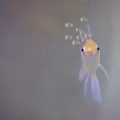Lorikaria: lifestyle, compatibility with other fish
This is a fairly large fish, the body length of which iscan reach 15 cm. Like other catfish, loricaria lead a bottom-dwelling lifestyle. Their special feature is a sucker mouth, with the help of which the fish can stay afloat even in a strong current. In an aquarium, this mouth serves them to scrape off fouling from snags, glass, stones and large plant leaves. Lorikaria - a conscientious cleaneraquariumFoto: Getty Also the difference between the lorikarii and other species can be considered that it practically does not float, but simply creeps from place to place. These catfishes have a peace-loving character and are quietly neighbors with other non-aggressive species. The body of the fish is covered with bone plates, which protect it from predators. A distinctive feature of the male is the presence of brushes on his pectoral fins. The most active pet becomes after twilight.
Lorikaria - a conscientious cleaneraquariumFoto: Getty Also the difference between the lorikarii and other species can be considered that it practically does not float, but simply creeps from place to place. These catfishes have a peace-loving character and are quietly neighbors with other non-aggressive species. The body of the fish is covered with bone plates, which protect it from predators. A distinctive feature of the male is the presence of brushes on his pectoral fins. The most active pet becomes after twilight.
Maintenance and breeding of the larynx
Considering the size of the fish, the volume of the aquarium for themshould be at least 100 liters. Small pebbles or carefully cleaned river sand should be poured onto its bottom. It is also worth placing aquarium plants with wide leaves, driftwood, large stones and grottoes in the vessel. The water temperature should be approximately 22–24°C, acidity 7 pH, and hardness – no more than 15°GH. Feeding these catfish will not cause any trouble – they eat both live and dry food. The main thing is that it falls to the bottom. Subdued lighting is recommended, because the fish begin to hide under the plants from bright light. You can even darken the aquarium. At the age of 1 year, catfish become sexually mature. Their breeding does not require a separate aquarium. You only need to create the necessary conditions in the one in which they live:
- put on the bottom of a few tubes of plastic or ceramic, a length of about 15 cm and a diameter of 2 to 3 cm;
- raise the water temperature to 26-29 ° C, and reduce the hardness to 10 ° GH;
- replace some of the water with fresh water.
The female will spawn in the tubes, and the maleguard it for 8 days. Then the tube should be taken out of the aquarium, holding it with your hands on both sides, and moved to the breeding tank. The male will remain in the tube the entire time. After the fry emerge from the tube, the male should be moved back to the aquarium. Since the fry are susceptible to water pollution, the water should be changed periodically, cleaning it with activated carbon. It is recommended to feed the fry with rotifers, small dry food, crushed egg yolk or brine shrimp. When choosing a fish, make sure that it is mobile and active. Then caring for it will not cause trouble even for a novice aquarist. Also on the topic:









